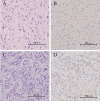Imaging features of localized IDH wild-type histologically diffuse astrocytomas: a single-institution case series
- PMID: 36646712
- PMCID: PMC9842655
- DOI: 10.1038/s41598-022-25928-2
Imaging features of localized IDH wild-type histologically diffuse astrocytomas: a single-institution case series
Abstract
Isocitrate dehydrogenase wild-type (IDHwt) diffuse astrocytomas feature highly infiltrative patterns, such as a gliomatosis cerebri growth pattern with widespread involvement. Among these tumors, localized IDHwt histologically diffuse astrocytomas are rarer than the infiltrative type. The aim of this study was to assess and describe the clinical, radiographic, histopathological, and molecular characteristics of this rare type of IDHwt histologically diffuse astrocytomas and thereby provide more information on how its features affect clinical prognoses and outcomes. We retrospectively analyzed the records of five patients with localized IDHwt histologically diffuse astrocytomas between July 2017 and January 2020. All patients were female, and their mean age at the time of the initial treatment was 55.0 years. All patients had focal disease that did not include gliomatosis cerebri or multifocal disease. All patients received a histopathological diagnosis of diffuse astrocytomas at the time of the initial treatment. For recurrent tumors, second surgeries were performed at a mean of 12.4 months after the initial surgery. A histopathological diagnosis of glioblastoma was made in four patients and one of gliosarcoma in one patient. The initial status of IDH1, IDH2, H3F3A, HIST1H3B, and BRAF was "wild-type" in all patients. TERT promoter mutations (C250T or C228T) were detected in four patients. No tumors harbored a 1p/19q codeletion, EGFR amplification, or chromosome 7 gain/10 loss (+ 7/ - 10). We assessed clinical cases of localized IDHwt histologically diffuse astrocytomas that resulted in malignant recurrence and a poor clinical prognosis similar to that of glioblastomas. Our case series suggests that even in patients with histologically diffuse astrocytomas and those who present with radiographic imaging findings suggestive of a localized tumor mass, physicians should consider the possibility of IDHwt histologically diffuse astrocytomas.
© 2022. The Author(s).
Conflict of interest statement
The authors declare no competing interests.
Figures




Similar articles
-
Clinical characteristics and radiological features of glioblastoma, IDH-wildtype, grade 4 with histologically lower-grade gliomas.Brain Tumor Pathol. 2023 Apr;40(2):48-55. doi: 10.1007/s10014-023-00458-5. Epub 2023 Mar 29. Brain Tumor Pathol. 2023. PMID: 36988764 Review.
-
Adult IDH wild type astrocytomas biologically and clinically resolve into other tumor entities.Acta Neuropathol. 2015 Sep;130(3):407-17. doi: 10.1007/s00401-015-1454-8. Epub 2015 Jun 19. Acta Neuropathol. 2015. PMID: 26087904
-
ATRX and IDH1-R132H immunohistochemistry with subsequent copy number analysis and IDH sequencing as a basis for an "integrated" diagnostic approach for adult astrocytoma, oligodendroglioma and glioblastoma.Acta Neuropathol. 2015 Jan;129(1):133-46. doi: 10.1007/s00401-014-1370-3. Epub 2014 Nov 27. Acta Neuropathol. 2015. PMID: 25427834
-
The prognostic role of IDH mutations in homogeneously treated patients with anaplastic astrocytomas and glioblastomas.Acta Neuropathol Commun. 2019 Oct 17;7(1):156. doi: 10.1186/s40478-019-0817-0. Acta Neuropathol Commun. 2019. PMID: 31623667 Free PMC article.
-
Diffuse astrocytic glioma, IDH-Wildtype, with molecular features of glioblastoma, WHO grade IV: A single-institution case series and review.J Neurooncol. 2021 Mar;152(1):89-98. doi: 10.1007/s11060-020-03677-4. Epub 2021 Jan 3. J Neurooncol. 2021. PMID: 33389563 Review.
Cited by
-
Clinical characteristics and radiological features of glioblastoma, IDH-wildtype, grade 4 with histologically lower-grade gliomas.Brain Tumor Pathol. 2023 Apr;40(2):48-55. doi: 10.1007/s10014-023-00458-5. Epub 2023 Mar 29. Brain Tumor Pathol. 2023. PMID: 36988764 Review.
-
Patterns of T2-FLAIR discordance across a cohort of adult-type diffuse gliomas and deviations from the classic T2-FLAIR mismatch sign.Neuroradiology. 2024 Apr;66(4):521-530. doi: 10.1007/s00234-024-03297-z. Epub 2024 Feb 13. Neuroradiology. 2024. PMID: 38347151
References
-
- Wijnenga MMJ, et al. Molecular and clinical heterogeneity of adult diffuse low-grade IDH wild-type gliomas: Assessment of TERT promoter mutation and chromosome 7 and 10 copy number status allows superior prognostic stratification. Acta Neuropathol. 2017;134:957–959. doi: 10.1007/s00401-017-1781-z. - DOI - PubMed
Publication types
MeSH terms
Substances
LinkOut - more resources
Full Text Sources
Medical
Research Materials
Miscellaneous

